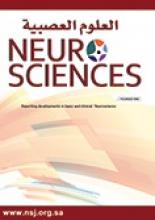LetterCorrespondence
Open Access
Subdural hematoma caused by rupture of a posterior cerebral artery aneurysm
Mahmood D. Al-Mendalawi
Neurosciences Journal October 2016, 21 (4) 374-375; DOI: https://doi.org/10.17712/nsj.2016.4.20160388
Mahmood D. Al-Mendalawi
Department of Pediatrics, Al-Kindy College of Medicine, Baghdad University, Baghdad, Iraq

References
- ↵
- Feng Z,
- Tan Q,
- Li L,
- Chen Z
- ↵
- Krischek B,
- Tatagiba M
- ↵
- Biesbroek JM,
- Rinkel GJ,
- Algra A,
- van der Sprenkel JW
- ↵
- Taylor A,
- Lefeuvre D,
- Levy A,
- Candy S
- ↵
- Pagiola IC,
- Paiva AL,
- de Aguiar GB,
- de Oliveira AC,
- Conti ML,
- Gagliardi RJ
- ↵
- Huang MB,
- Ye L,
- Liang BY,
- Ning CY,
- Roth WW,
- Jiang JJ,
- et al.
- ↵
- Dhomne S,
- Rao C,
- Shrivastava M,
- Sidhartha W,
- Limaye U
- ↵
- Fugate JE,
- Lyons JL,
- Thakur KT,
- Smith BR,
- Hedley-Whyte ET,
- Mateen FJ
- ↵
- Ducruet AF,
- Hickman ZL,
- Zacharia BE,
- Narula R,
- Grobelny BT,
- Gorski J,
- et al.
- ↵
- Chen Z,
- Miao H,
- Feng H,
- Zhu G
- ↵
- Modi G,
- Ranchod K,
- Modi M,
- Mochan A
- ↵
- Chen Z,
- Chen J,
- Miao H,
- Li F,
- Feng H,
- Zhu G
- ↵
- Honda M,
- Tsutsumi K,
- Yokoyama H,
- Yonekura M,
- Nagata I
In this issue
Subdural hematoma caused by rupture of a posterior cerebral artery aneurysm
Mahmood D. Al-Mendalawi
Neurosciences Journal Oct 2016, 21 (4) 374-375; DOI: 10.17712/nsj.2016.4.20160388
Jump to section
Related Articles
- No related articles found.
Cited By...
- No citing articles found.





